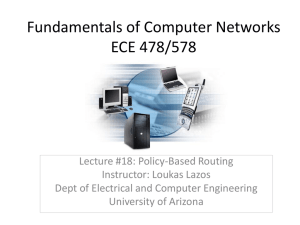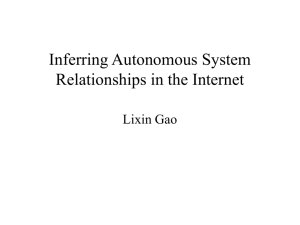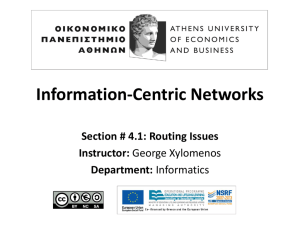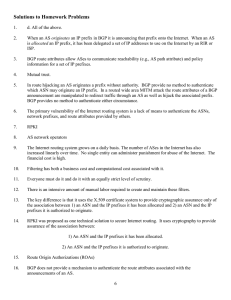BGP Configuration Wyatt Lloyd
advertisement
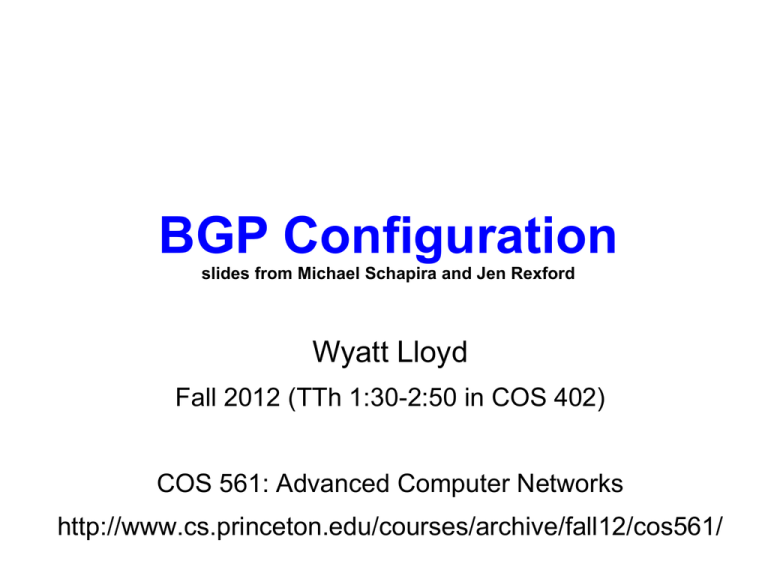
BGP Configuration slides from Michael Schapira and Jen Rexford Wyatt Lloyd Fall 2012 (TTh 1:30-2:50 in COS 402) COS 561: Advanced Computer Networks http://www.cs.princeton.edu/courses/archive/fall12/cos561/ Local Control vs. Global Properties The Internet is a “network of networks” –~35,000 separately administered networks –Competitive cooperation for e2e reachability Local Control Intradomain routing, interdomain policies Global Properties Performance, security, reliability, scalability 2 Two-Tiered Routing Architecture • Goal: distributed management of resources –Internetworking of multiple networks –Networks under separate administrative control • Intradomain: inside a region of control –Routers configured to achieve a common goal –Okay for routers to share topology information –Different ASes can run different protocols • Interdomain: between regions of control –ASes have different (maybe conflicting) goals –Routers only share reachability information 3 Internet Structure 4 Autonomous Systems (ASes) • AS-level topology –Nodes are Autonomous Systems (ASes) –Destinations are prefixes (e.g., 12.0.0.0/8) –Edges are links and business relationships 4 3 5 2 1 Client 7 6 Web server 5 AS Numbers (ASNs) ASNs are 16 bit values (or 32-bit). 64512 through 65535 are “private” Currently around 35,000 in use. • • • • • • • • • Level 3: 1 MIT: 3 Harvard: 11 Yale: 29 Princeton: 88 AT&T: 7018, 6341, 5074, … Verizon: 701, 702, 284, 12199, … Sprint: 1239, 1240, 6211, 6242, … … 6 Business Relationships Between ASes • Neighboring ASes have business contracts –How much traffic to carry –Which destinations to reach –How much money to pay • Common business relationships –Customer-provider –Peer-peer –Backup –Sibling 7 Customer-Provider Relationship • Customer needs to be reachable from everyone – Provider ensures all neighbors can reach the customer • Customer does not want to provide transit service – Customer does not let its providers send traffic through it Traffic to the customer Traffic from the customer d provider provider traffic customer d customer 8 Peer-Peer Relationship • Peers exchange traffic between customers – AS lets its peer reach (only) its customers – AS can reach its peer’s customers – Often the relationship is settlement-free (i.e., no $$$) Traffic to/from the peer and its customers peer d traffic peer 9 AS Structure: Tier-1 Providers • Top of the Internet hierarchy –Has no upstream provider of its own –Typically has a large (inter)national backbone –Around 10-12 ASes: AT&T, Sprint, Level 3, … peer-peer peer-peer peer-peer peer-peer 10 AS Structure: Other ASes • Lower-layer providers (tier-2, …) –Provide transit service to downstream customers But need at least one provider of their own –Typically have national or regional scope E.g., Minnesota Regional Network –Includes a few thousand ASes • Stub ASes –Do not provide transit service –Connect to upstream provider(s) –Most ASes (e.g., 85-90%) –E.g., Princeton 11 Policy-Based Path-Vector Routing 12 Shortest-Path Routing is Restrictive • All traffic must travel on shortest paths • All nodes need common notion of link costs • Incompatible with commercial relationships National ISP1 Regional ISP3 Cust3 National ISP2 Regional ISP2 Cust2 YES NO Regional ISP1 Cust1 13 Path-Vector Routing • Extension of distance-vector routing –Support flexible routing policies –Faster convergence(avoid count-to-infinity) • Key idea: advertise the entire path –Distance vector: send distance metric per dest d –Path vector: send the entire path for each dest d “d: path (2,1)” 3 “d: path (1)” 1 2 data traffic data traffic d 14 Faster Loop Detection • Node can easily detect a loop – Look for its own node identifier in the path – E.g., node 1 sees itself in the path “3, 2, 1” • Node can simply discard paths with loops – E.g., node 1 simply discards the advertisement “d: path (2,1)” 3 “d: path (1)” 2 “d: path (3,2,1)” 1 15 Flexible Policies • Each node can apply local policies – Path selection: Which path to use? – Path export: Whether to advertise the path? • Examples – Node 2 may prefer the path “2, 3, 1” over “2, 1” – Node 1 may not let node 3 hear the path “1, 2” 2 3 1 2 3 1 16 Border Gateway Protocol Border Gateway Protocol • Prefix-based path-vector protocol • Policy-based routing based on AS Paths • Evolved during the past 20 years • 1989 : BGP-1 [RFC 1105], replacement for EGP • 1990 : BGP-2 [RFC 1163] • 1991 : BGP-3 [RFC 1267] • 1995 : BGP-4 [RFC 1771], support for CIDR • 2006 : BGP-4 [RFC 4271], update “BGP at 18”: http://www.youtube.com/watch?v=HAOVNYSnL7k 18 BGP Operations Establish session on TCP port 179 AS1 BGP session Exchange all active routes AS2 Exchange incremental updates While connection is ALIVE exchange route UPDATE messages 19 Incremental Protocol • A node learns multiple paths to destination –Stores all of the routes in a routing table –Applies policy to select a single active route –… and may advertise the route to its neighbors • Incremental updates –Announcement Upon selecting a new active route, add node id to path … and (optionally) advertise to each neighbor –Withdrawal If the active route is no longer available … send a withdrawal message to the neighbors 20 BGP Route • Destination prefix (e.g., 128.112.0.0/16) • Route attributes, including – AS path (e.g., “7018 88”) – Next-hop IP address (e.g., 12.127.0.121) 192.0.2.1 AS 7018 12.127.0.121 AT&T AS 88 AS 11 Yale Princeton 128.112.0.0/16 AS path = 88 Next Hop = 192.0.2.1 128.112.0.0/16 AS path = 7018 88 Next Hop = 12.127.0.121 21 BGP Path Selection • Simplest case AS 1129 –Shortest AS path –Arbitrary tie break • Example Global Access 128.112.0.0/16 AS Path = 1129 1755 1239 7018 88 –Three-hop AS path preferred over a five-hop AS path –AS 12654 prefers path through Global Crossing • But, BGP is not limited to shortest-path routing –Policy-based routing AS 12654 RIPE NCC RIS project 128.112.0.0/16 AS Path = 3549 7018 88 AS 3549 Global Crossing 22 BGP Policy: Influencing Decisions Open ended programming. Constrained only by vendor configuration language Receive Apply Policy = filter routes & BGP Updates tweak attributes Apply Import Policies Based on Attribute Values Best Routes Best Route Selection Best Route Table Apply Policy = filter routes & tweak attributes Transmit BGP Updates Apply Export Policies Install forwarding Entries for best Routes. IP Forwarding Table 23 BGP Policy: Applying Policy to Routes • Import policy –Filter unwanted routes from neighbor E.g. prefix that your customer doesn’t own –Manipulate attributes to influence path selection E.g., assign local preference to favored routes • Export policy –Filter routes you don’t want to tell your neighbor E.g., don’t tell a peer a route learned from other peer –Manipulate attributes to control what they see E.g., make a path look artificially longer than it is 24 BGP Policy Examples 25 Import Policy: Local Preference • Favor one path over another –Override the influence of AS path length –Apply local policies to prefer a path • Example: prefer customer over peer Local-pref = 90 Sprint AT&T Local-pref = 100 Tier-2 Tier-3 Yale 26 Import Policy: Filtering • Discard some route announcements –Detect configuration mistakes and attacks • Examples on session to a customer –Discard route if customer doesn’t own the prefix –Discard route containing other large ISPs Patriot USLEC Princeton 128.112.0.0/16 27 Export Policy: Filtering • Discard some route announcements –Limit propagation of routing information • Examples –Don’t announce routes from one peer to another UUNET AT&T Sprint 28 Export Policy: Filtering • Discard some route announcements –Limit propagation of routing information • Examples –Don’t announce routes for networkmanagement hosts or the underlying routers themselves USLEC network operator Princeton 29 Export Policy: Attribute Manipulation • Modify attributes of the active route –To influence the way other ASes behave • Example: AS prepending –Artificially inflate AS path length seen by others –Convince some ASes to send traffic another way Sprint USLEC Patriot 88 88 Princeton 128.112.0.0/16 88 30 BGP Policy Configuration • Policy languages are vendor-specific –Not part of the BGP protocol specification –Different languages for Cisco, Juniper, etc. • Still, all languages have some key features –Policy as a list of clauses –Each clause matches on route attributes –… and discards or modifies the matching routes • Configuration done by human operators –Implementing the policies of their AS –Biz relationships, traffic engineering, security, …31 BGP Inside an AS 32 An AS is Not a Single Node • Multiple routers in an AS –Need to distribute BGP information within the AS –Internal BGP (iBGP) sessions between routers AS1 eBGP iBGP AS2 33 Internal BGP and Local Preference • Example – Both routers prefer the path through AS 100 on the left – … even though the right router learns an external path AS 200 AS 100 AS 300 Local Pref = 90 Local Pref = 100 I-BGP AS 256 34 Joining BGP and IGP Information • Border Gateway Protocol (BGP) –Announces reachability to external destinations –Maps a destination prefix to an egress point 128.112.0.0/16 reached via 192.0.2.1 • Interior Gateway Protocol (IGP) –Used to compute paths within the AS –Maps an egress point to an outgoing link 192.0.2.1 reached via 10.1.1.1 10.1.1.1 192.0.2.135 An AS May Learn Many Routes • Multiple connections to neighboring ASes –Multiple border routers may learn good routes –… with the same local-pref and AS path length Multiple links 4 3 5 2 7 6 1 36 Hot-Potato (Early-Exit) Routing • Hot-potato routing – Each router selects the closest egress point – … based on the path cost in intradomain protocol • BGP decision process – Highest local preference – Shortest AS path – Closest egress point – Arbitrary tie break dst A 3 4 D 8 10 3 8 F 5 B 9 E 4 G C hot potato 37

